The City of Victoria’s Plans for the Future
When we think about implementing and developing a more sustainable future, we look to our leaders for guidance, help, and resources. In 2018, the City of Victoria developed a Climate Leadership Plan, outlining sustainability goals, targets, and actions for Victoria.
To help make the Plan and all of the fantastic information it contains more accessible, I summarized the Plan, including an introduction and its five main sections: Low-Carbon High-Performance Buildings, Low-Carbon Mobility, Low-Carbon Waste Management, Municipal Operations, and Adapting Early.
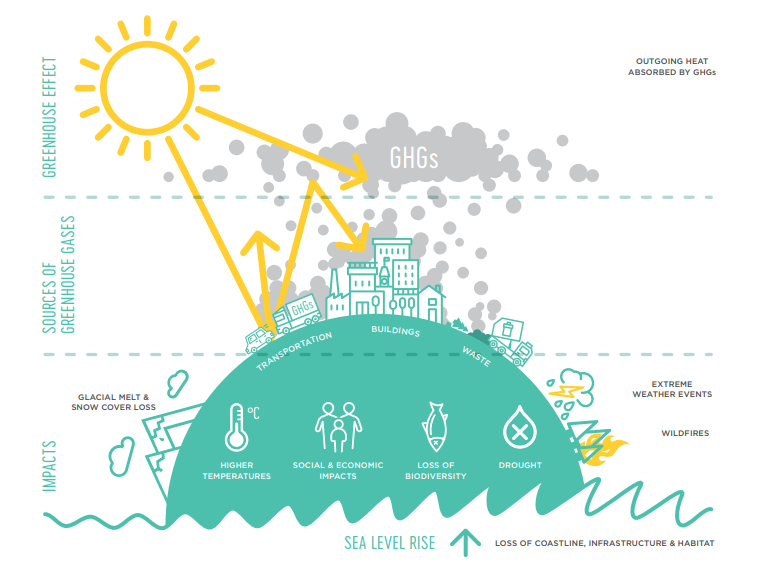
Introduction
The City of Victoria starts off by introducing its vision of a “vibrant, healthy, and prosperous community, fueled by renewable low carbon energy systems, and designed and integrated in ways that promote a high quality of life for all Victorians” by 2050.
The Plan discusses where we’re at right now. The main areas contributing to Victoria’s carbon footprint are “the energy used to heat buildings, the fuels that propel vehicles, and what becomes of waste after it is discarded”. In 2017, Victoria emitted 370,000 tonnes of GHGs, 50% of which came from buildings, 40% from transportation, and 10% from waste. Our electricity is relatively clean, however, with nearly all of BC’s power grid supply coming from renewable hydropower. We are already at 40% of our energy being renewable!
It also outlines their goals for what Victoria will look like by the mid-century. The City wants to reduce our greenhouse gas (GHG) emissions by 80% and shift from GHG-intensive fossil fuels to 100% renewable energy by 2050. This does not mean that we are starting from scratch. We are moving in the right direction already; we just need to intensify our efforts.
Finally, it lists the ten Climate Leadership Planning Principles that will guide the next steps and inform the process.
- Lead and inspire: The City will be a regional and national leader on climate mitigation and adaption, taking urgent action to drive innovative GHG reductions.
- Harmonize climate action to secure co-benefits: GHG reduction should be integrated into City planning in all areas, including health, safety, affordability, etc.
- Universal accountability: All Victorians have an important role to play in reducing GHGs and should be encouraged to take meaningful action.
- Make energy visible: Data for Victoria’s energy use, GHG performance, and climate impacts should be available and known to help drive effective change.
- Evidence-based decisions: Decisions regarding energy usage and GHG reduction should be socially minded, cost-effective, and supported by science and technology.
- Renewable energy for all: All Victorians, regardless of circumstances, must have easy access to affordable and renewable energy options.
- Dismantle barriers: The City will remove barriers to rapid decarbonization of our energy and support smart energy choices in their policies.
- Climate resilience is developed early: To avoid the most disruptive economic, social, and environmental impacts of climate change, Victoria must take urgent, early, and meaningful action.
- Think globally, change locally, partner regionally
- Track and Adjust: The City will track and report on its progress and targets every year, making adjustments if and when needed.
The “largest, least expensive, most benign, most quickly deployable, least visible, least understood, and most neglected way to provide energy services” is to maximize energy efficiency. That is one of the places that is first on the priority list for the City and where it wants us all to start.
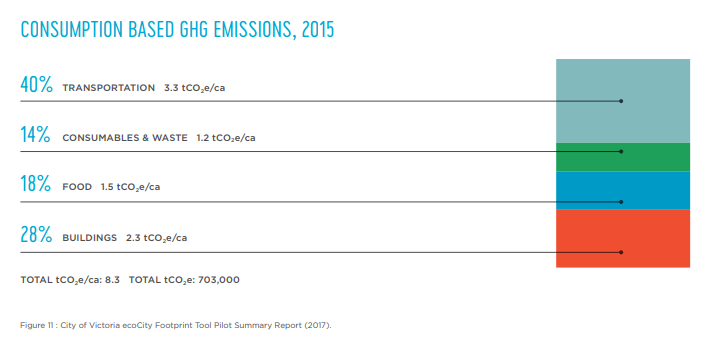
Low-Carbon High-Performance Buildings
Building-related GHGs account for 50% of Victoria’s emissions and mainly come from the combustion of heating oil and natural gas. The City plans to work with government partners and local stakeholders to “develop strategies and actions to make low carbon building retrofits affordable and timely”.
Switching from oil and gas furnaces to air source heat pumps could save up to 50,000 tonnes of carbon dioxide every year. That’s more than 13% of what we need to cut to reach the 2050 targets! A heat pump upgrade can also save between 40% and 75% off homeowners’ annual heating bills.
Goals
- All buildings are highly energy efficient
- All buildings are powered by renewable energy
Targets
- By 2030, all new buildings are “net-zero energy ready”.
- By 2050, all existing buildings meet new high-efficiency standards
- By 2030, heating oil is phased out.
- By 2050, all buildings exclusively use renewable energy.
Actions Already Being Taken
- Adopt the BC Energy Step Code, creating a road map towards net-zero energy ready buildings by 2030
- Renew the City’s Sustainability Checklist to include Step Code requirements for new buildings, as well as sustainable building design elements that align with City goals
- Design and deliver customized deep energy retrofit programs for rental apartment buildings
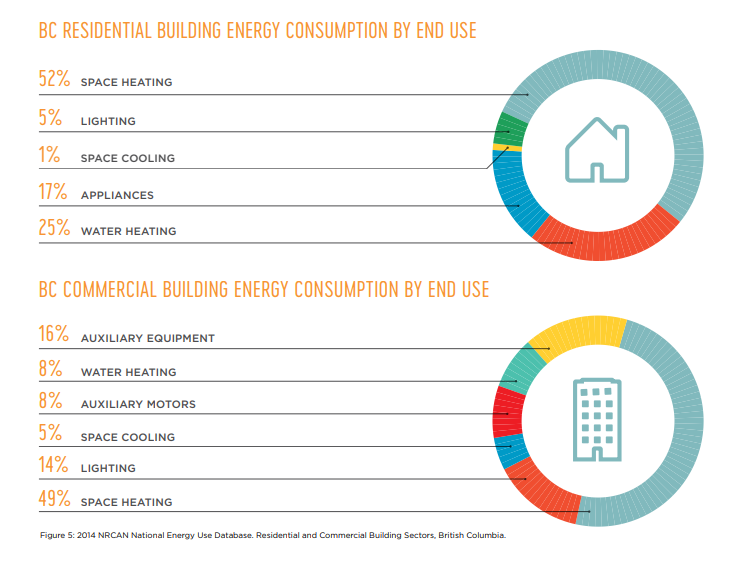
Low-Carbon Mobility
Transportation makes up 40% of our GHG emissions, with most of that coming from burning gasoline in our passenger vehicles and diesel fuel in commercial vehicles. The City wants to “make alternatives to gasoline and diesel-fuelled vehicles more compelling” by encouraging the use of renewably powered vehicles, expanding walking and cycling infrastructure, and more!
Their plan is to “reduce the number of vehicles in Victoria, the number of kilometres they are driven, and the frequency of driving alone.”
Goals
- All Victorians have access to low carbon, high-performance, and affordable multi-modal transportation
- Vehicles in Victoria are powered by renewable energy
- Smart land-use minimizes transportation emissions
Targets
- By 2030, 25% of all trips by Victoria residents are taken by public transportation.
- By 2030, 100% of BC Transit business are renewably powered.
- By 2030, Victoria residents choose walking and cycling for 55% of all trips.
- By 2030, renewable energy powers 30% of passenger vehicles registered in Victoria, and 100% of passenger vehicles are renewably powered by 2050.
- By 2030, 30% of commercial vehicles operating in Victoria are renewably powered.
- By 2030, 100% of Victoria’s neighbourhoods are “complete” by design with substantial transportation system diversity.
Actions Already Being Taken
- Complete the City’s Sustainable Mobility Strategy (SMS), which will allow the city to develop the management systems, programs, and other tools to optimize and transform the movement of people, goods, and services. As part of the SMS, the City will set specific targets for reducing single-occupancy vehicle use, vehicle kilometres traveled, and vehicle ownership. It will also adopt multi-modal service indicators and identify performance criteria for “complete” neighbourhoods and transportation service diversity
- Invest annually in the design and construction of new walking and cycling infrastructure, including secure bike parking in the downtown core and in village centres.
- Expand EV charging stations in City parkades, recreation centres, community centres, and public spaces.
- Invest in ‘transit-signal priority’ measures to reduce transit wait times in the downtown core.
- Sponsor community-led events, educational programs, and celebrations that encourage the use of low carbon transportation.
- Advocate for energy performance requirements in provincial ride-sharing regulations.
- Expand car share services in the downtown core and village centres.
- Support the expansion of electric buses, including BC Transit and other commercial fleets, through infrastructure and permit programs.
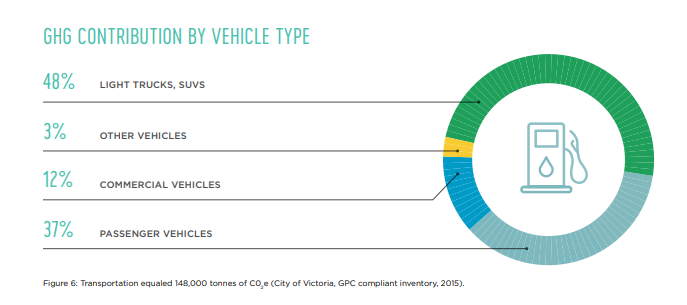
Low-Carbon Waste Management
GHG emissions from waste mostly come from organic materials in our landfill breaking down. This releases methane, which is 25 times more potent than CO2. The organic waste in Hartland Landfill produces the equivalent of 27,000 tonnes of CO2, which amounts to about 7% of our community’s emissions.
Kitchen scraps and food waste are still the largest source of waste at our landfill, roughly 21% of it or 75 kilograms per person per year. Other organic materials that generate methane at a slower rate, such as wood, paper, and textiles, make up an additional 38% of Hartland’s intake. “Reducing GHGs from waste will require major reductions in waste disposal.”
The best and smartest way to reduce waste-related GHG emissions is to reduce the amount of waste we generate in the first place.
Goals
- Organic materials are managed to avoid GHG emissions (ie: food and yard waste, wood, paper, textiles)
Targets
- Eliminate 100% of food and yard waste sent to the landfill by 2030.
- Eliminate 100% of other organic materials sent to the landfill by 2030.
- Capture methane from collected organic waste to provide renewable energy by 2025.
Actions Already Being Taken
- Continually improve the residential kitchen and yard waste collection and diversion programs, including for multi-family residences.
- Foster behaviour change to reduce food waste through the “Love Food Hate Waste” educational campaign.
- Partner with CRD to deliver a regional, industrial treatment facility for organic waste by 2025.
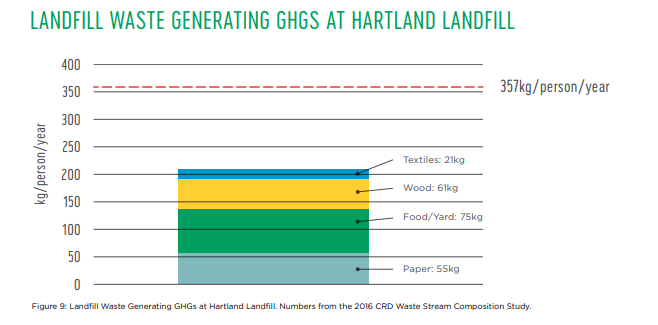
Municipal Operations
Much like the rest of Victoria, the City’s corporate GHG emissions come from “the combustion of fossil fuels to provide heat and hot water to buildings and to operate the City’s fleet”. They account for about 1% of our total community emissions, which is equivalent to 3,400 tonnes.
The City plans to reduce GHGS by upgrading efficiency in buildings, improving vehicle efficiency and reducing fuel demand, and shifting from fossil-fuel burning equipment to those that run on electricity, renewable natural gas, hydrogen, or advanced biofuels. For instance, in 2016, the City added “three e-bikes, eight hybrid vehicles, and nine electric vehicles to its fleet”. The Victoria Conference Centre now runs on 100% renewable natural gas. The City has replaced 6,700 street lights with energy-efficient LEDs to reduce energy use by 50%, “avoiding an estimated $200,000 in energy costs per year”.
Goals
- The City is a recognized leader in climate mitigation and adaptation.
- The City takes integrated and informed climate action.
- The City will provide timely and accurate data supporting strong climate mitigation and adaptation actions.
Targets
- By 2040, all City facilities are powered 100% by renewable energy. All new City facilities are renewably powered.
- By 2025, all City power tools and small engine-driven equipment are renewably powered.
- By 2040, 80% of the City fleet is electrified or renewably powered.
- By 2020, capital and operating plans are informed by climate data, carbon pricing, and the City’s GHG reduction targets.
- By 2022, the City has developed a “triple bottom line” accounting system that guides City business planning by assessing and balancing environmental and social risks and financial costs and opportunties.
- By 2022, partner with other local governments and the region to develop a community-accessible Energy and GHG information management System (EGIMS) to define, communicate, and track community energy and GHG reduction across all sectors.
Actions Already Being Taken
- Establish a two-year staff corporate energy and climate action position using matching funds from an external partner. Join BC Hydro’s Corporate Energy Manager Program.
- Plan for City vehicle electrification systems and networks.
- Implement fleet telematics to identify vehicle and operational energy use patterns to inform decision-making.
- Reduce per-vehicle GHG emissions through fleet operation and maintenance as well as vehicle right-sizing.
- Partner with other municipalities and orders of government to support the development of the full suite of EVs required by municipal fleets.
- Develop the City’s web-based GHG / Energy education, awareness, and information exchange portal to promote information sharing and empower the public to achieve measurable, and trackable, GHG reductions.
- Pilot new technologies in City-owned assets to assess suitability for broad community application.

Adapting Early
In coming years, Victoria will “experience hotter and drier summers, warmer and wetter winters, rising sea levels, and more extreme storms” even if the global community reduces future carbon emissions. It is a matter of the severity of these issues and their effects.
With hotter summers, trees, parks, and gardens will be stressed, which could affect our ability to find and grow local, affordable food. Local flooding would be a more regular occurrence due to more intense rain storms and sea levels rising. Rising sea levels can also cause coastal erosion and ecosystem damage to our beautiful waterfront environment.
By acting early to anticipate climate change and its effects on our homes and the environment, we will avoid disruptive and expensive action later. “Climate change could cost Canada up to $43 billion per year by mid-century”, but that price tag “could be halved through early action”.
Goals
- All climate-related risks to City infrastructure are minimized through early and wise planning and action.
- Victoria’s natural environment flourishes in a changing climate.
- All Victorians are empowered and prepared for climate impacts and emergencies.
Targets
- Climate resilience is embedded into all City business.
- The City’s infrastructure and services are ready to protect and respond to the risks associated with a changing climate.
- Natural habitats support healthy fish, wildlife, and plant populations and healthy ecosystem function.
- The community is knowledgeable and prepared to address the impacts from a changing climate.
- The City incorporates best practices in risk communication covering all climate hazards.
- Climate resilience enhances the quality of life for all Victorians, especially the most vulnerable.
Actions Already Being Taken
- Develop the ‘business case for adaptation’ to demonstrate the benefits of taking early action
- Conduct a community-wide climate vulnerability and risk assessment
- Assess how existing City plans incorporate climate risk and identify opportunities to align with ongoing and future City business.
- Seek funding, investment, and partnership opportunities to enhance the speed and quality of adaptation initiatives.
- Minimize flood risks through natural and engineered stormwater infrastructure.
- Continue to integrate climate change impacts in environmental management decisions.
- Increase native plantings on City-owned and -managed land to enhance biodiversity and support ecosystem migration
- Continue to improve public communication methods in advance of extreme weather events.
- Continue to integrate climate risks into emergency preparedness and recovery planning.
- Support projects and programs that increase resilience in populations vulnerable to climate change.

More Information:
For more details on how the City of Victoria plans to inspire and elicit sustainable change, check out the full Climate Leadership Plan document.
Another resource to check, including programs and rebates, is the City of Victoria’s webpage on Sustainability.
We Can Rise to the Challenge!
Meeting BC and Canada’s environmental climate change goals for 2050 will be a challenge. It will mean we need to rethink how we live our lives, research better options, and develop strategies for reusing resources and reducing waste. We will all need to work together, but it is possible and we can do it!

